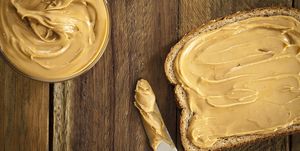
Tahini is kind of the ingredient equivalent to a familiar face you can’t quite place—you know you’ve heard of it, but you can’t remember why or where.
It’s most commonly associated with hummus, although you can now find it in a variety of recipes ranging from salad dressings to cookies. (Yes, cookies.)
Apparently tahini is pretty useful—but what the heck is it and where can you find it?
What is tahini?
Okay, so you might already know (and if you didn’t, then now you do) that tahini is simply ground sesame seeds. Like its roasted peanut and almond cousins, the paste is made by grinding sesame seeds and—voila!

You’ll often find tahini used in traditional Mediterranean recipes, but its roots date back as far as 5000 BC, when it was cultivated in India, according to The Splendid Table. It’s also been suggested that tahini’s origins can be traced back to present-day Iran, reports Serious Eats, where it is better known as ardeh. So yeah, it’s got a lot of history.
Tahini can either be made from hulled or unhulled (whole) sesame seeds, but Vandana R. Sheth, R.D.N., points out that unhulled packs a bigger nutritional punch, simply because the entire seed is ground into the paste.
Where can you get it?
Even though tahini sounds like an obscure or exotic ingredient, you might be surprised to discover it located next to peanut butter in your average grocery aisle. You can also make your own at home (try this recipe from blogger Minimalist Baker) with a few simple ingredients and tools—all you need is sesame seeds, olive oil, and a food processor.
Most store-bought tahini is made from hulled seeds, which are lighter than unhulled seeds. But, according to TheKitchn.com, if you use unhulled, toasted seeds, you’ll get a nuttier flavor (in addition to more nutrition). You can even make tahini from black sesame seeds.
Is tahini good for you or what?
Put simply, yes. Sheth says, even though tahini is high in fat (eight grams per tablespoon), most of the fat is in the form of mono and poly unsaturated fats (a.k.a. heart healthy).
Tahini Nutrition (2 tbps): 178 cal, 16 g fat, 6.4 g carbs, 2.8 g fiber, 5.2 g protein.
“Tahini also provides magnesium, phosphorus, iron, calcium, zinc, potassium, methionine, vitamin E, and B vitamins,” she says. Plus, your body can more easily absorb the nutrients from sesame seeds when they are crushed as opposed to whole. Sheth says in addition to contributing to overall heart health, tahini boosts skin and bone health, and can decrease inflammation.
How do I use it?
Even though tahini is primo in recipes like hummus and salad dressing, it might be fun to branch out a bit and try one of the trendier ways to use it, like these Tahini, Orange & Chocolate Chip Cookies from Lazy Cat Kitchen.
View this post on Instagram
While I’m pondering if it’s prudent to turn some wild fungi we found in the forest earlier on today into dinner 🙄🍄⏳🚑 , #ontheblog a batch of #vegancookies with tahini, orange, cardamom and chocolate chunks 😜 they are #oilfree, can be #glutenfree and #refinedsugarfree too. Enjoy 😘 #veganbaking #whatveganseat #whatfatveganseat #feedfeed @thefeedfeed.vegan #bestofvegan #thrivemags #glutenfreevegan #veganfood #vehanfoodspace #veganfoodshare #tahini #leteathealthy #letseatvegan #letscookvegan
A post shared by Lazy Cat Kitchen (@lazycatkitchen) on
But if dessert tahini isn’t your thing, then you can always try it in one of these new spins on old favorites, like Delish’s Cauliflower Hummus or Middle Eastern-Inspired Chicken with Tahini Sauce.
Source: Read Full Article
